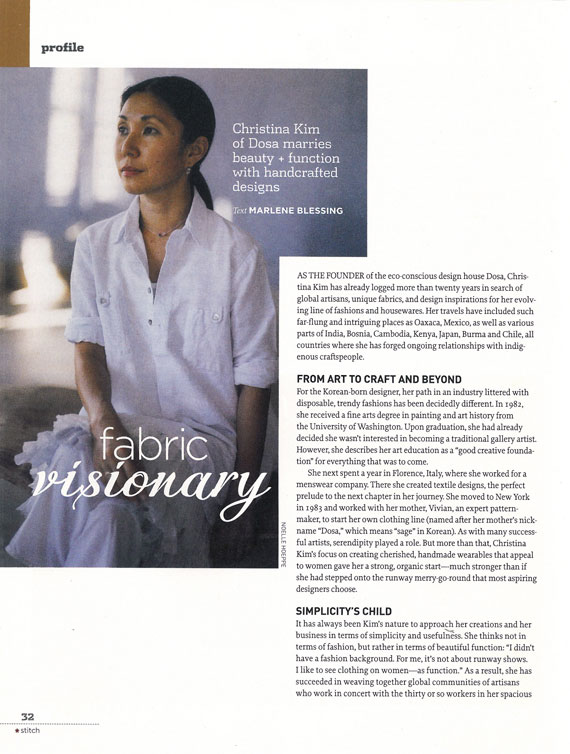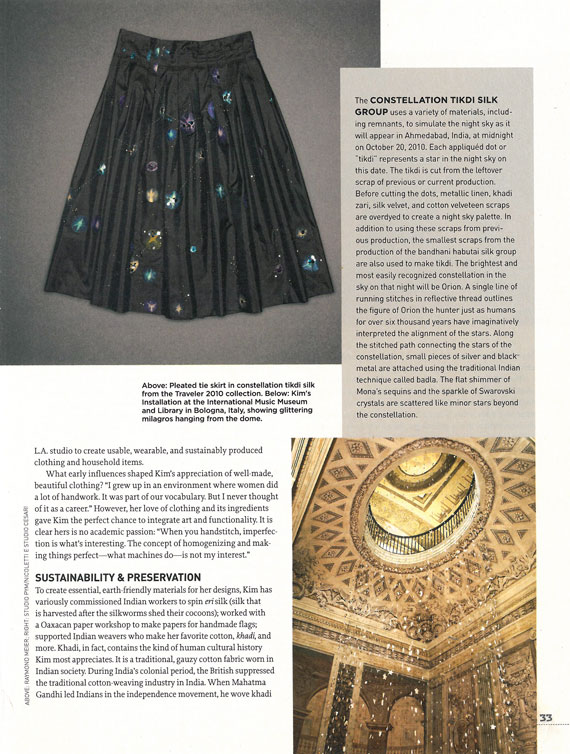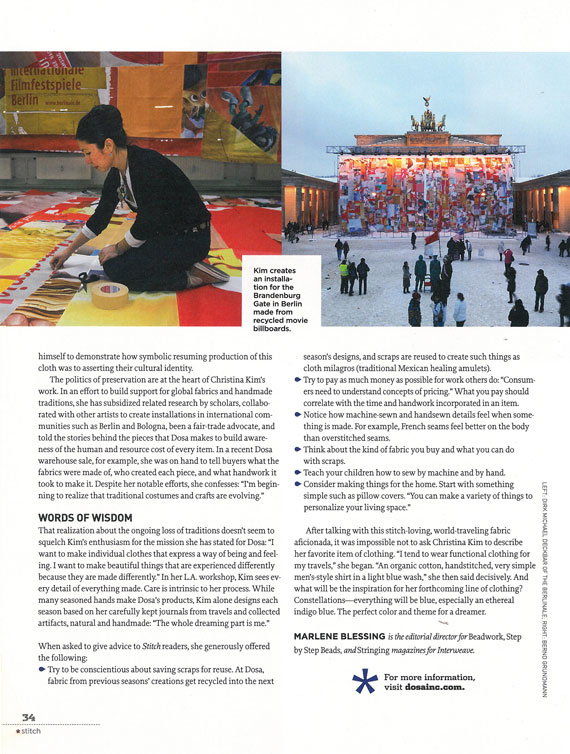As the founder of the eco-conscious design house Dosa, Christina Kim has already logged more than twenty years in search of global artisans, unique fabrics, and design inspirations for her evolving line of fashions and housewares. Her travels have included such far-flung and intriguing places as Oaxaca, Mexico, as well as various parts of India, Bosnia, Cambodia, Kenya, Japan, Burma, and Chile, all countries where she has forged ongoing relationships with indigenous craftspeople.
From Art to Craft and Beyond
For the Korean-born designer, her path in an industry littered with disposable, trendy fashions has been decidedly different. In 1982, she received a fine arts degree in painting and art history from the University of Washington. Upon graduation, she had already decided she wasn’t interested in becoming a traditional gallery artist. However, she describes her art education as a “good creative foundation” for everything that was to come.
She spent a year in Florence, Italy, where she worked for a menswear company. There she created textile designs, the perfect prelude to the next chapter in her journey. She moved to New York in 1983 and worked with her mother, Vivian, an expert patternmaker, to start her own clothing line (named after her mother’s nickname “Dosa,” which means “sage” in Korean). As with many successful artists, serendipity played a role. But more than that, Christina Kim’s focus on creating cherished, handmade wearables that appeal to women gave her a strong, organic start – much stronger than if she had stepped onto the runway merry-go-round that most aspiring designers choose.
Simplicity’s Child
It has always been Kim’s nature to approach her creations and her business in terms of simplicity and usefulness. She thinks not in terms of fashion, but rather in terms of beautiful function: “I didn’t have a fashion background. For me, it’s not about runway shows. I like to see clothing on women – as function.” As a result, she has succeeded in weaving together global communities of artisans who work in concert with the thirty or so workers in her spacious L.A. studio to create usable, wearable, and sustainably produced clothing and household items.
What early influences shaped Kim’s appreciation of well-made, beautiful clothing? “I grew up in an environment where women did a lot of handwork. It was part of our vocabulary. But I never thought of it as a career.” However, her love of clothing and its ingredients gave Kim the perfect chance to integrate art and functionality. It is clear hers is no academic passion: “When you handstitch, imperfection is what’s interesting. The concept of homogenizing and making things perfect – what machines do- is not my interest.”
Sustainability & Preservation
To create essential, earth-friendly materials for her designs, Kim has variously commissioned Indian workers to spin eri silk (silk that is harvested after the silkworms shed their cocoons); worked with a Oaxacan paper workshop to make papers for handmade flags: supported Indian weavers who make her favorite cotton, khadi, and more. Khadi, in fact, contains the kind of human cultural history Kim most appreciates. It is a traditional, gauzy cotton fabric worn in Indian society. During India’s colonial period, the British suppressed the traditional cotton – weaving industry in India. When Mahatma Gandhi led Indians in the independence movement, he wove khadi himself to demonstrate how symbolic resuming production of this cloth was to asserting their cultural identity.
The politics of preservation are at the heart of Christina Kim’s work. In an effort to build support for global fabrics and handmade traditions, she has subsidized related research by scholars, collaborated with other artists to create installations in international communities such as Berlin and Bologna, been a fair-trade advocate, and told the stories behind the pieces that Dosa makes to build awareness of the human and resource cost of every item. In a recent Dosa warehouse sale, for example, she was on hand to tell buyers what the fabrics were made of, who created each piece, and what handwork it took to make it. Despite her notable efforts, she confesses: “I’m beginning to realize that traditional costumes and crafts are evolving.”
Words of Wisdom
That realization about the ongoing loss of traditions doesn’t seem to squelch Kim’s enthusiasm for the mission she has stated for Dosa: “I want to make individual clothes that express a way of being and feeling. I want to make beautiful things that are experienced differently because they are made differently.” In her L.A. workshop, Kim sees every detail of everything made. Care is intrinsic to her process. While many seasoned hands make Dosa’s products, Kim alone designs each season based on her carefully kept journals from travels, artifacts, natural and handmade: “The whole dreaming part is me.”
When asked to give advice to Stitch readers, she generously offered the following:
Try to be conscientious about saving scraps for reuse. At Dosa, fabric from previous seasons’ creations get recycled into the next season’s designs, and scraps are reused to create such things as cloth Milagros (traditional Mexican healing amulets).
Try to pay as much money as possible for work others do: Consumers need to understand concepts of pricing.” What you pay should correlate with the time and handwork incorporated in an item.
Notice how machine-sewn and handsewn details feel when something is made. For example, French seams feel better on the body than overstitched seams.
Think about the kind of fabric you buy and what you can do with scraps.
Teach your children how to sew by machine and by hand.
Consider making things for the home. Start with something simple such as pillow covers. “You can make a variety of things to personalize your living space.”
After talking with this stitch-loving, world-traveling fabric aficionada, it was impossible not to ask Christina Kim to describe her favorite item of clothing. “I tend to wear functional clothing for my travels: she began. “An organic cotton, handstitched, very simple, men’s style shirt in a light blue wash,” she then said decisively. And what will be the inspiration for her forthcoming line of clothing? Constellations – everything will be blue, especially an ethereal indigo blue. The perfect color and theme for a dreamer.
text: Marlene Blessing
photo: Noelle Hoeppe, Raymond Meier, Studio Pym, Dirk Michael Dekbar, Bernd Grundmann


